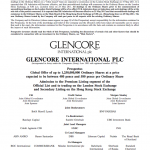
The total number of shares subscribed for by cornerstone investors in Glencore’s IPO, which is targeting proceeds of about US$10 billion (excluding a 10% over-allotment option), is expected to represent approximately 31% of the global offer, assuming the overallotment option is not exercised. The US$3.1 billion tranche therefore represents one of the largest cornerstone books by value ever achieved for an IPO. But there are consequences to the practice, which could come back and haunt the issuer as well as other investors in the company.
Glencore’s IPO includes one of the largest syndicates of underwriters seen in recent times for an IPO of that size. The line up boasts no fewer than two joint sponsors, three global co-ordinators, five joint bookrunners, three co-bookrunners, three joint lead managers, six co-lead managers and six co-managers – and that doesn’t even include the commercial banks distributing the retail offer in Hong Kong. All are set to share fees of 1.575%, with an additional 0.175% payable to Citi and Morgan Stanley as a praecipuum. A further commission of up to US$82.5 million may also be paid by Glencore, in its discretion, to one or more banks within 30 days of listing.
But aside from a very busy tombstone, and a substantial fee pool, what is also particularly remarkable about the Glencore deal is the size and depth of its cornerstone tranche.
| Cornerstone investors in the Glencore IPO | |
| Commitment | |
| Investor | (US$m) |
| Aabar | 850 |
| GIC | 400 |
| BlackRock | 360 |
| Brookside Capital | 225 |
| Fidelity | 215 |
| Eton Park Funds | 200 |
| York Capital | 200 |
| Credit Suisse | 175 |
| Och-Ziff | 175 |
| Pictet | 100 |
| UBS AG | 100 |
| Zijin | 100 |
| Total | 3100 |
| Source: IPO price range prospectus | |
The roster comprises the familiar mix of sovereign wealth funds from Asia and the Middle East, asset managers, hedge funds and private banks. The investors in Glencore’s US$2.2 billion going-public convertible bond issued in December 2009 also feature prominently, making a total list of 12 names together subscribing for US$3.1 billion.
That compares to a US$5.45 billion cornerstone tranche of 11 investors for the US$12 billion H share IPO (part of a larger, global $22.1 billion deal) of Agricultural Bank of China in July 2010, which came to market in particularly volatile market conditions. But it is substantially larger than the US$1.92 billion tranche of six investors (more than half of which through a single investment by the Kuwait Investment Authority) in the US$20.4 billion IPO of AIA in October 2010, and the $1.62 billion tranche of eight investors in the US$5.45 billion IPO of Hutchison Ports Holdings Trust in Singapore last March.
Unlike in Singapore, the cornerstone investors in the Glencore deal will be locked up for six months, as is required in Hong Kong under the listing rules.
This is also the first time the practice will have featured so prominently in a deal in Europe and, should it become adopted more widely, could provide a well-needed push to a lackluster ECM market there.
For the lead banks, the process is a no brainer. They will receive fees on amounts allocated to cornerstones, and this also ensures that the deal can be launched safe in the knowledge that demand for almost a third of the IPO – which has received a fair share of coverage as a controversial deal, and also comes as the market for primary offerings appears to be shifting for the worse – has readily been secured.
It also gives a strong signal to wider universe of investors that leading names are endorsing the offering, and also believe in the investment case.
And it could lead to profitable block business down the line for the bookrunners too.
Both the company and investors, however, should perhaps worry that such sizeable individual holdings of stock could markedly depress the share price as the lock-ups near their expiry date.
While the deal has reportedly been covered on the first day of bookbuilding (but then, as was the HPH Trust deal, which since had a rather poor showing in the aftermarket), the overhang will no doubt be felt in the months to come, unless clear statements are issued about the long-term nature of the cornerstones’ commitments.
It’s all in the name after all: cornerstones only hold things neatly in place until they collapse – and bring the whole house down.
